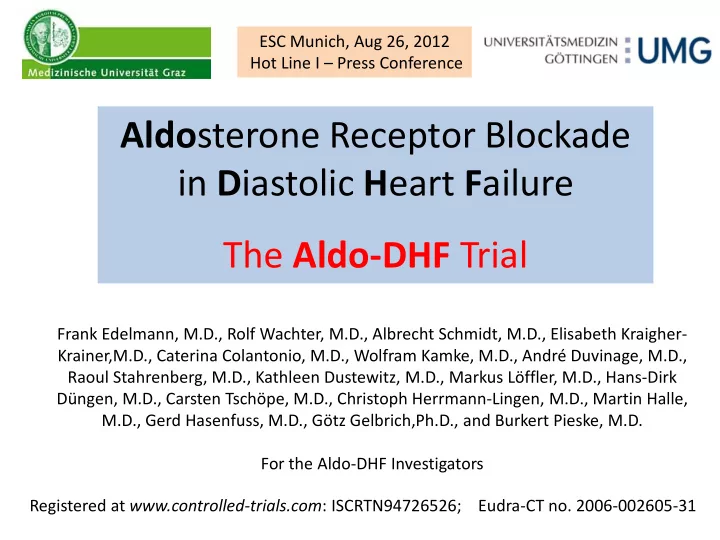

ESC Munich, Aug 26, 2012 Hot Line I – Press Conference Aldo sterone Receptor Blockade in D iastolic H eart F ailure The Aldo-DHF Trial Frank Edelmann, M.D., Rolf Wachter, M.D., Albrecht Schmidt, M.D., Elisabeth Kraigher- Krainer,M.D., Caterina Colantonio, M.D., Wolfram Kamke, M.D., André Duvinage, M.D., Raoul Stahrenberg, M.D., Kathleen Dustewitz, M.D., Markus Löffler, M.D., Hans-Dirk Düngen, M.D., Carsten Tschöpe, M.D., Christoph Herrmann-Lingen, M.D., Martin Halle, M.D., Gerd Hasenfuss, M.D., Götz Gelbrich,Ph.D., and Burkert Pieske, M.D. For the Aldo-DHF Investigators Registered at www.controlled-trials.com : ISCRTN94726526; Eudra-CT no. 2006-002605-31
Disclosures No disclosures related to this trial. The trial was funded after peer review by the German Federal Ministry of Education and Research within the Clinical Trials program (Grant No. 01GI0205) The Sponsor of the Trial according to German Drug Law was the University of Göttingen, Germany
Background Diastolic Heart Failure (DHF, or Heart Failure with Preserved Ejection Fraction) accounts for over 50% of all heart failure cases. Clinical outcomes are poor in DHF, but no established therapy exists. Aldosterone has been implicated in the pathogenesis of DHF via aldosterone receptor mediated myocardial fibrosis, hypertrophy, and vascular stiffening. Aldo-DHF was designed to test the efficacy and safety of the aldosterone receptor antagonist Spironolactone in patients with diastolic heart failure.
Aldo-DHF Study Design • Multicenter, randomised, placebo-controlled double-blind, two- armed parallel-group study • Hypothesis: Spironolactone (25 mg) improves cardiac (diastolic) function and exercise capacity as compared to placebo after 1 year of therapy • Co-Primary endpoints: E/é (echo tissue Doppler derived estimate of filling pressure) and maximal exercise capacity (peak VO 2 on bicycle spiroergometry) • Key inclusion criteria: Signs/symptoms of heart failure, EF ≥50%, evidence of diastolic dysfunction, peak VO 2 <25ml/kg/min • 422 patients were randomised to Spironolactone or Placebo
Co-Primary endpoints E/é peak VO 2 p = 0.57 p = 0.81 p < 0.001 p < 0.001 1 Placebo 1 Change in peak VO 2 0.5 Placebo Change in E/e‘ 0 0 Spironolactone Spironolactone -1 -0.5 Baseline 6 months 12 months Baseline 6 months 12 months Time since randomisation
Secondary endpoints Left ventricular mass index NT-proBNP p = 0.009 p = 0.09 p = 0.03 p = 0.16 0.05 Placebo Change in Log10 NT-proBNP (ng/L) 0 Change in LVMI (g/m 2 ) 0 Placebo -0.05 -5 -0.10 -10 Spironolactone Spironolactone -0.15 Baseline 6 months Baseline 12 months 12 months 6 months Time since randomisation
Safety endpoints: Adverse events Adverse Events Spironolactone Placebo (n=209) P-value (n,%) (n=213) Deaths 0 (0) 1 (<1) 1·00 Hospitalisation 50 (24) 60 (28) 0·38 Cardiac 15 (7) 21 (10) 0·38 Non-cardiac 37 (18) 47 (22) 0·27 New/worsening 44 (21) 35 (16) 0·26 edema Worsening renal 43 (21) 77 (36) <0·001 function eGFR <30 mL/min/1·73m 2 at 1 (<1) 3 (1) 0·62 last visit New/worsening 18 (9) 34 (16) 0·03 anaemia Gynaecomastia 1 (<1) 9 (4) 0·02 Serum potassium ever increased >5·0 22 (11) 44 (21) 0·005 mmol/L ever increased >5·5 3 (1) 4 (2) 1·00 mmol/L
Summary and Conclusions 1. Aldo-DHF is the largest mechanistic Phase IIb trial in DHF 2. Spironolactone (25mg/d) improved diastolic function (E/é), induced structural reverse remodelling (LVMI), and reduced neuroendocrine activation (NT-proBNP) 3. Spironolactone did not improve exercise capacity , NYHA class, or quality of life 4. Spironolactone reduced blood pressure; effects on cardiac structure and function remained significant after adjusting for blood pressure changes 5. Spironolactone was safe and not associated with severe adverse events 6. Spironolactone can be considered in patients with diastolic heart failure for improving cardiac function and blood pressure control
Recommend
More recommend